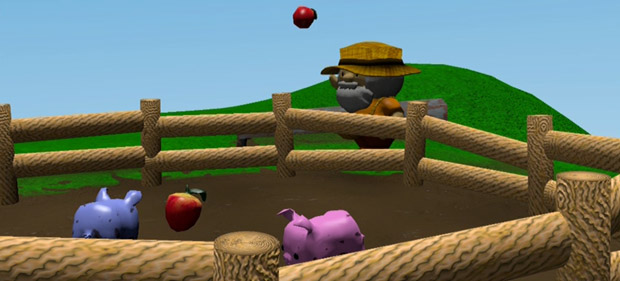These are some game prototypes that were created or contributed to by me.

167EA3A7CDB14C0162DEC6863CDEF9E43EDE6FE475E52E3129B108D20A030E283A95EA85A9ABE8C91F2167E33A730EC22BD1F3DE381BAFED0E6195EB8899BD856C92A65D229F6714F568C5F70B0BB35D19FC6E5035D83E0E3025FA5E63680F236F1BFCCDEFE225B12B7E8E64A4A0D972D304D06B583C2AEB52373457B9042F4A57CC0D65FFC686D41E14B0EFDB0CAB1FC5ADF09533C87C998D5A09CC650D7F74349A281E2E708B26D6653561BBB424F8461A25C9C90D890E9376462B4BA14E92F0AB0014E293A1E8004630C387AE5C5ADEB43A2DCD9A6D7B61BAFBA19A7EAC22AAC6F26FBE7E24BA4FE4962DCD2A482707A5FD40B0A2C7408B92C034B2C26AAC
More Info
This game was exhibited with other Victoria University student work at UX11 Experience Design Forum!
Design
- Environment, Item and UI Design by Ben Cotton
- Original Concept and Character Design by Cornelia Tan
Programming
- Core Mechanics by Calvin Kaye
- Hunger System and Scoring by Edwin Monk-Fromont
- AI and Reactions by Liam O'Connor
- Statistics and Heads-Up Display/UI by Steven Warner
This action-packed casual game was the result of a group project to create a 3D
game in Blender.
You are a pig.
You have been placed in a pen with another pig.
A farmer throws food into the pen.
The object of the game: to collect food for yourself and starve the other pig as
soon as possible.
Read development blog
Greedy Grunters (aka Hungry Piggies II)
More Info
For a startup I was involved in (Spoink Games!), Hungry Piggies was redeveloped as a 2.5D Flash game designed to integrate with Facebook.
In this instance I was responsible for the bulk of the development work, as well as some UI design.
Im-Able Hand Accuracy Test Game
This small game was developed for Im-Able to appear on their website, as a way to engage potential customers. Im-Able makes computer peripherals to help victims of strokes and other brain injuries recover their hand and limb mobility, so the intent of this game was to provide a very basic means for people to compare the motor skills of their different hands.
On this project I was responsible for UI design, including instructional animations, and the bulk of the development work.
More Info
- Original Concept and Programming by Ben Cotton
- Character Animation by Mark Strachan
- Prop Design by Broughton Elliott
- Sound by Vikesh Patel
- Level Design by Rhygan Hart
This game originated with a game proposal conceived and presented by me. On the
strength of the proposal, a group was formed to implement a working prototype of
the game.
My core gameplay concept was based on the idea of camouflage, while the aesthetic
I formulated from German Expressionism and Pop Art.
You play a genetically-engineered chameleon who has broken free in a science lab.
With your super powers of camouflage you mission is to liberate the other chameleons
being held and escape the building.
While in the darkness you are completely invisible, however under coloured lights
you are visible if your skin is a different colour than the light. With the use
of batteries you can change your skin to different colours, to disguise yourself
under the different coloured lights. However, often you can also use the batteries
to change the colour of the lights themselves, through the use of battery-powered
switches located around the facility.
Out to get you are numerous security cameras and most importantly, roaming robotic
guards. Luckily, these are also battery-powered, so you can kill these enemies by
sneaking up behind them and stealing their batteries. In this way, you can replenish
your ability to change camouflage while thwarting the enemy.
Read development blog
More Info
I created this proof-of-concept game for a brief to animate and put
in context a game character that would encourage players to protect the environment.
As "Garbage Fish", your mission is to lead the smaller fish to safety through a
floating mass of garbage, while picking up pieces of refuse along the way to clear
a path.
Read development blog
The Loss of Anonymity - an interactive narrative
More Info
The world is becoming increasingly interconnected. Every day more and more things
that we take for granted are integrating with the Internet, due to the many advantages
of such connectivity. Arguably, one area where this is happening most of all is
the world of gaming. Bringing the Internet into gaming has greatly expanded the
possibilities of the medium. Virtual worlds and social games have brought otherwise
isolated people together and enhanced the entertainment value of the medium.
In parallel to this increasing interconnectedness, is the advance of the surveillance
society. CCTV cameras are increasingly being used in the real world to prevent crime
across the planet, while governments introduce legislation to give them the power
to track people’s movements through invasive identification and security measures
(such as the proposed NZ Search and Surveillance Bill), brought on by threats of
terrorism and crime, and the paranoia induced by them.
Read full paperRead development blog